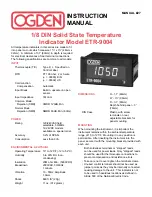
2013/7/25
17
5.2 Module Cleaning Instructions
Solution Mixture:
Solution Mixture:
Solution Mixture:
Solution Mixture: clean water with low mineral amount, non-abrasive/ non-caustic detergent,
weak acid/weak alkalescent solution, or solution of PH < 10. Do not use high pressure spray.
Cleaning
Cleaning
Cleaning
Cleaning Tool:
Tool:
Tool:
Tool: soft brush, non-conductive brush, non-abrasive sponge, non-abrasive cloth,
seamless cloth
1.
Clean module and glass surface with solution and tool described as above.
2.
If dirty area on glass surface which is hard to be cleaned such as oily substances, try to
use commercial glass detergent, alcohol, isopropanol (IPA), or sodium bicarbonate
solution.
3.
Use clean water to rinse glass clean of all cleaning solution. Dry wet modules using a
clean and dry cloth. Do not leave stagnant water on glass surface.
5.3 Cleaning the Frame
BenQ Solar module frames include an anodic oxide coating to increase produce life. The
cleaning cycle for regular anodic oxide coatings is generally every six months. When
cleaning, be sure not to damage or scratch this coating.
Dirt can generally be cleaned off using a suitable lubricant or warm, mild soapy water, and a
fiber brush may be used to clean any dust that may also stick to the surface. Do not use
abrasive cleaning tools like steel wool or acidic/ alkaline chemicals to clean. (Reference
:
GB
5237.2, Wrought aluminum alloy extruded profiles for architecture)
5.4 Visual inspection of the module
During regular cleaning cycles, be sure to visually inspect each module. The purpose of visual
inspection is to detect possible faults or damage. Specifically:
Possible broken glass.
Rust on the circuits and soldering of the PV cells. Normally this is due to moisture
entering the module through a breakage in the encapsulating layer during installation or
transport.
5.5 Inspecting connections and cabling
While performing preventive maintenance every 6 months, carrying out the following
operations:



































